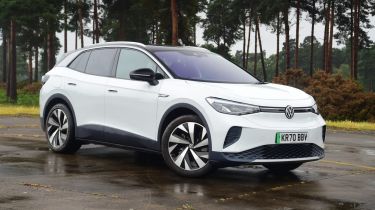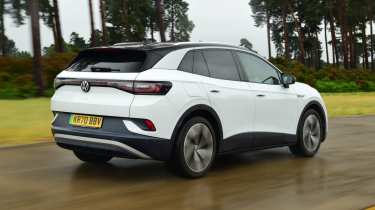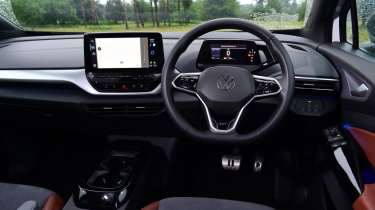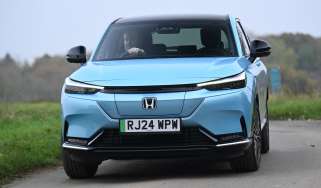Used Volkswagen ID.4 (Mk1, 2021-date) buyer’s guide: low prices make EV an attractive buy
A full used buyer’s guide on the Volkswagen ID.4, covering the ID.4 Mk1 that’s been on sale 2021
Verdict
It’s no secret that the used electric car market is in turmoil, with manufacturers forced to sell more new cars than the market can stand. Values are tumbling, and it’s used-car buyers who are benefiting, because the market is awash with cars that are far more enticing on a used basis. The Volkswagen ID.4 is typical in this respect; at more than £40,000 new in many cases, it’s easy to choose a rival EV or an ICE car for the same money. But when you’re paying only half as much for the same car on a barely used basis, this smart-looking Volkswagen is far more appealing, even if it’s no market leader.
The new-car market is so over-run with electric cars now, it seems incredible that five years ago there were comparatively few models to choose from. But momentum was building and after Volkswagen showed its ID concept at the 2016 Paris motor show, a lot of people were anticipating the company’s first electric car.
It would take another four years for the ID to come to market as the ID.3, and once this family hatch had made its debut, it was the turn of the ID.4 SUV just a few months later.
Used - available now
Since then, Volkswagen’s EV portfolio has grown significantly with some impressive models, considering how new to EVs VW is.
History
The ID.4 went on sale in the UK in January 2021, in 201bhp 77kWh First Edition form only. Three months later the Pro Performance Life was added to the range in Family and Max forms, all with a 77kWh battery. The more affordable 146bhp Pure and 168bhp Performance editions came in May 2021, with a choice of City and Style trims; both had a 52kWh battery.
No options (aside from colours and wheels) were available on the ID.4 until July 2021, when VW saw fit to introduce them, alongside the 296bhp ID.4 GTX and high-spec GTX Max. Both had the 77kWh battery.
The 171bhp ID.4 Pro appeared in January 2022 as a new entry level for the 77kWh battery, then in November 2023 came an updated ID.4 range with a new infotainment system and 170kW charging for 4WD models instead of the old 135kW.
On the road
Lightning-quick acceleration is the norm with EVs, but VW has dialled it down in the ID.4 to help driveability. Yet it’s quick enough; most models can do 0-62mph in less than seven seconds. It’s a shame the ID.4 isn’t more engaging to drive with its light steering, while the soft suspension means plenty of wallow in bends – but this does ensure a more comfortable ride. The 19-inch wheels give a much better ride than the 20-inch alternative.
Which should I buy?
Early cars with the bigger (77kWh) battery, which gives up to a claimed 336 miles, are the cheapest used options. Not only are these the most practical day-to-day, but they’re also the ones that will be easier to sell on.
If you’re buying a car to tow with, all ID.4s can pull 1,000kg, although the twin-motor GTX edition increases this limit to 1,400kg.
Even entry-level cars have LED headlights, navigation, dual-zone climate control, adaptive cruise control and heated front seats.
Alternatives to the Volkswagen ID.4
The Nissan Ariya was our 2022 Car of the Year, thanks to its engaging dynamics, impressive interior quality and practical cabin. The Hyundai Ioniq 5 is another excellent family-friendly car that looks great and is roomy, just like its cousin, the Kia EV6, which is also well equipped and good to drive. It also has the attraction of a superb seven-year warranty.
The Tesla Model Y is a best-seller for lots of reasons, not least its range, access to the firm’s Supercharger network and a roomy cabin.
Related to the ID.4 are the Audi Q4 e-tron, Cupra Born and Skoda Enyaq, while the BMW iX3, Ford Mustang Mach-E, Lexus RZ, Peugeot E-3008, Renault Scenic E-Tech and Volvo EX30 are all worth a closer look.
What to look for
Drive on
All ID.4s are rear-wheel drive, apart from the GTX, which features a motor at each end to give permanent four-wheel drive, dubbed 4Motion by VW.
Lost connections
ID.4s have over-the-air (OTA) software update technology, so you can do updates at home. But sometimes the car won’t connect and a dealer has to intervene.
Tyred out
Factory-supplied Bridgestone tyres come with 6mm of tread instead of the usual 8mm. They will wear quickly – potentially in as little as 12,000 miles.
Going spare
No spare wheel (nor even a can of sealant) is supplied, because the Bridgestone tyres are ‘self-sealing’, and just need to be pumped up if there’s a puncture. Space saver spares are available.
Interior
Yes, the ID.4’s cabin is hi-tech, but there’s still plenty of room for improvement. Not only are some of the materials of a lower quality than you’d expect from this semi-premium brand, but too many of the features are controlled through the touchscreen.
It’s the same with the multi-function steering wheel, which has piano-black controls that look and feel cheap. There’s plenty of equipment though, with even entry-level models having heating for the steering wheel and windscreen.
On the upside, the cabin is very spacious, with ample head and legroom for those in the back seat, while the boot is cavernous at 543 litres, or 1,575 litres with the back seat down.
Running costs
servicing is needed only every two years, regardless of the mileage, and each service costs £248, plus £63 for fresh brake fluid at every visit.
Buy lower down the range and group 18 insurance shouldn’t sting too much, although the biggest-selling models are in groups 24-32. The fastest models are in group 39 though, which is on a par with a Porsche Macan S.
Running costs will be low if you can charge at home; VW claims 3.6 miles per kilowatt-hour, owners report 3.2-3.4, and we achieved 3.4.
ID.4s will be subject to £190 road tax, and will not be subject to the usual six-year £410 surcharge that applies to cars whose initial list price was more than £40k. New ID.4s registered from April will be subject to the charge, however.
Recalls
Across its entire electric model range, VW has issued just five recalls over the past three years, for three different faults.
One of these was for the ID.7, while the ID.3 and ID.4 were subject to two recalls apiece. The first ID.3 and ID.4 recall came in November 2021, but just a handful of cars made in March and April 2021 were affected. These left the factory with faulty steering racks, requiring the fitment of a replacement rack.
A second ID.4 recall came in May 2024 and it also affected the ID.7; this time it was for cars made between August 2022 and April 2024 because of problematic back-seat latches that didn’t properly secure the seats.
Driver Power owner satisfaction
None of VW’s EVs has appeared in our Driver Power New Car surveys yet, with only ICE cars represented. In the 2024 survey, there were four Volkswagens, and none did well. The Golf Mk8 finished in 50th, while the other three were the Tiguan Mk2 (45th), Polo Mk6 (41st) and T-Roc (35th). With VW coming 29th out of 32 in this year’s Brands survey, the company clearly has a lot of work to do to keep its customers happy.
Did you know you can sell your car with Auto Express? Get the highest bid from our network of over 5,500 dealers and we'll do the rest. Click here to try Auto Express Sell My Car now...
















